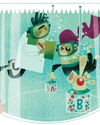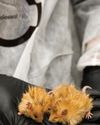Intentar ORO - Gratis
THE LEFT OVERS
Muse Science Magazine for Kids
|April 2024
A lot has happened for modern humans to get to this point. We lost most of our hair, learned how to make tools, established civilizations, sent a person to the Moon, and invented artificial intelligence. Whew! With all of these changes, our bodies have changed, too. It’s only taken us about six million years.

It all comes back to one key idea: evolution.
In 1859, Charles Darwin published his book On the Origin of Species, in which he explained his theory of evolution. He described the process of “descent with modification,” where physical parts— and even behaviors—of animals may change over multiple generations due to natural selection. If certain traits—such as sharp teeth or thick fur—helped the animal survive in the wild, then these favorable traits would be “selected for” and passed down to the next generation. Then that generation would pass them on. And so on.
And while favorable traits are passed on, other traits are sometimes phased out altogether. Unused parts are called vestiges. This word comes from the Latin vestigium, or “footprint.” These vestiges are our body’s evolutionary leftovers.
Chew on This
Modern humans (Homo sapiens) and our ancestors are all referred to as hominins. There have been many different types of hominins over the millennia.
Starting about three million years ago, hominins created simple tools that could cut, pound, and grind food materials like raw plants. They also harnessed the power of fire, which could be used to cook meats and other foods, making them more digestible. Soon hominins consumed less cellulose, a strong structural material found in plants that is difficult for many animals to digest. Then something funny happened along the six million years’ march toward modern Homo sapiens: Our jaws grew smaller, and our brains grew bigger. As our ancestors’ eating habitats changed, over time the hominin jawbone shrank. Our teeth grew smaller, too.
Esta historia es de la edición April 2024 de Muse Science Magazine for Kids.
Suscríbete a Magzter GOLD para acceder a miles de historias premium seleccionadas y a más de 9000 revistas y periódicos.
¿Ya eres suscriptor? Iniciar sesión
MÁS HISTORIAS DE Muse Science Magazine for Kids

Muse Science Magazine for Kids
ANIMAL FIREFIGHTER TO THE RESCUE
Can animals help manage the risks of deadly wildfires?
3 mins
Muse July 2025: The Story Behind Wildfires

Muse Science Magazine for Kids
FIRE DANGER
WHY THE RISK OF WILDFIRES KEEPS GROWING
4 mins
Muse July 2025: The Story Behind Wildfires

Muse Science Magazine for Kids
The Miller NEW Normal
WHAT TODAY’S WILDFIRES TELL US ABOUT OUR FUTURE
8 mins
Muse July 2025: The Story Behind Wildfires

Muse Science Magazine for Kids
WOMEN AND FIREFIGHTING: A GOOD FIT
Jessica Gardetto is a firefighter. Her father was, too. “I grew up with my dad coming home smelling like wildfire and covered in soot,” she says.
1 min
Muse July 2025: The Story Behind Wildfires

Muse Science Magazine for Kids
What is happening on your fingertips when they get all wrinkly in a hot tub?
—Felix G., age 10, Montana
1 mins
Muse July 2025: The Story Behind Wildfires

Muse Science Magazine for Kids
WHEN the SMOKE CLEARS
THE LINGERING EFFECTS OF THE RECENT PACIFIC PALISADES AND ALTADENA EATON FIRES
6 mins
Muse July 2025: The Story Behind Wildfires

Muse Science Magazine for Kids
PICKING TEAMS
Keep it fair with a strategy that relies on geometry.
2 mins
Muse July 2025: The Story Behind Wildfires

Muse Science Magazine for Kids
SHAN CAMMACK
WILDLIFE BIOLOGIST AND FIRE SAFETY OFFICER
3 mins
Muse July 2025: The Story Behind Wildfires

Muse Science Magazine for Kids
Scientists Create Mice With Woolly Mammoth-Like Fur
RESEARCHERS AT A COMPANY IN TEXAS ARE WORKING TO CREATE A LIVING ANIMAL THAT RESEMBLES THE EXTINCT WOOLLY MAMMOTH. Recently, they produced mice with traits of the large mammal. The mice all have coats with mammoth-like fur, and some of the small mammals also have genes that help them store fat. Both features would help the animals survive in the cold Arctic, where the woolly mammoth once lived.
1 min
Muse July 2025: The Story Behind Wildfires

Muse Science Magazine for Kids
Cool Sunshade Added to the Nancy Roman Space Telescope
THE NANCY ROMAN SPACE TELESCOPE IS A NEW TELESCOPE THAT NASA IS BUILDING AND WILL LAUNCH INTO SPACE, LIKELY IN EARLY 2027.
1 min
Muse July 2025: The Story Behind Wildfires
Listen
Translate
Change font size
